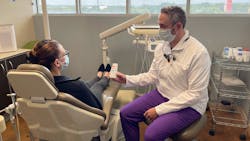Growing up as the son of a dentist, I had no caries throughout my entire childhood. I graduated from high school in the spring of 1997 and set off to my freshman year at the University of Texas. I came home that next summer and had a hygiene recall appointment. In that freshman year at UT, I grew eight interproximal lesions. Oops! I guess that’s what happens when you raise your consumption of...umm...fermentable carbohydrates and get lax on your oral hygiene habits. I didn’t just graduate from high school; I also graduated from low caries risk to high caries risk!
After my restorations were done, I was told that I needed to get serious about my hygiene habits again. In addition, I was prescribed the cornerstone of caries prevention—fluoride. More specifically, sodium fluoride 5000 ppm dentifrice. I am fairly picky about my dentifrice; taste, texture, and foaming are all important to me. I tried about five or six different 5000 ppm fluoride dentifrices, and my favorite by far is Prevident 5000 Booster. That became my everyday toothpaste then, and it remains so to this day.
Personal recommendations and hard data
Since then, I have had one restoration done. I speak passionately about this to my high caries risk patients: This is what I use in my mouth, and it has kept me from needing a restoration for years! That personal endorsement is great and all, but I am just an N of 1. What does the data say? Thankfully, Sikka Software Corporation has done some research supported by Colgate, and the results will surprise you.1
Sikka is a data analytics company focusing on retail health care. They took on the challenge of answering the great question of preventive dentistry: Does fluoride use (in this case, Prevident 5000) actually benefit the patient?
Study specifics
The first step to answering this question was setting up the patient-selection method. For a study like this, we want to examine a lot of “average” patients to get an idea of their disease patterns. We know from other Sikka analytics studies that the typical patient receives 10 procedures over a two-year period in a dental office. Patients who were prescribed Prevident 5000 and have had at least 10 procedures before and after the prescription was written were selected to participate in the study. A total of 1,200 random patients from dental practices all over the country were chosen that matched these qualifications. Of them, 300 were millennials (22–37 years of age), 300 were Generation Xers (38–53 years of age), 300 were baby boomers (45–72 years of age), and, finally, 300 were in the Silent Generation (73–plus years of age). When procedural and cost data from these patients were examined, Sikka found an absolute advantage for patients who had been prescribed Prevident 5000.
In general, the patients who were prescribed Prevident 5000 spent less money on dentistry than patients who were not prescribed Prevident. Sikka investigated further to see where those savings came from. The category that patients saved on most was, by far, restorative dentistry. Patients who were prescribed Prevident 5000 spent, on average, 48% less on restorative dentistry. That adds up to an average total savings of $1,176 per patient on restorative dentistry. This figure represents a 16% savings on endodontic procedures, 11% savings on periodontal procedures, and an 11% savings on oral and maxillofacial surgery procedures. Those numbers are significant and staggering! This study shows us that we can help our patients spend less on dentistry by prescribing Prevident 5000. As dentists, we are probably the only business owners who would look at this as good news. If your favorite spa could give you a prescription that would decrease the amount of money you spent in the spa, would they do it? The answer is most likely no.
But dentistry is different. We are taught early on in dental school the value of preventive dentistry. As professionals who want the best for our patients, spending less on restorative dentistry with us is a good thing. But what about as business owners? Is it a good thing business-wise for us to prescribe Prevident 5000 to our patients? I would argue yes, and Sikka’s data backs me up.
I am a restorative dentist. I love performing restorative dentistry. However, I don't love performing caries-control procedures on high caries risk patients. Those appointments can be long, grueling, and painful for both the patient and my back and neck. I would much rather use my time to do comprehensive esthetic and restorative dentistry such as smile makeovers, veneers, full-mouth rehabilitation, and clear aligners. Those procedures keep me stimulated and excited much more than a quadrant of class II’s on a teen with high caries risk.
The study looked at the referral habits of patients who were prescribed Prevident 5000 versus those who were not. It turns out that, generally, patients who were prescribed Prevident referred more friends, family, and loved ones than those who were not. To me, that speaks to the increase in patient satisfaction that comes with a prevention-first approach. Those patients are just happier. They aren’t hit as often by the revolving door of re-restoration of teeth. They have more happy visits with less bad news of expensive treatment plans. Those happy patients pay it forward by referring about 20% more patients.
The study didn’t just stop at patient referrals when examining the success of practices that prescribe Prevident 5000. They utilized their proprietary Sikka Score,2 which is based on 10 different key performance indicators, to differentiate between the two groups of practices. On average, practices that prescribe Prevident 5000 have higher Sikka Scores than those that do not. Prescribing Prevident 5000 can lead to a more successful practice. It may do this by increasing patient satisfaction and experience. That type of increase is invaluable and can help offset losses in high caries risk dental procedures.
If you read my Pearls for Your Practice column in Dental Economics, you might know that I'm an avid baseball fan. One of my favorite baseball books is Moneyball. Moneyball taught me an entirely new way to look at the game based on analytics. Sikka has done the same with its study. My personal experience has told me that Prevident 5000 is a winner. Now, with this broad-reaching data, I know that prescribing Prevident 5000 is a winner. It is a winner for my patients because it saves them money and time. It is a winner for me because it makes my patients happier and raises the success of my practice. Prescribing Prevident 5000 is a grand slam!
Disclosure: The author, Joshua Austin, DDS, MAGD, received an honorarium from Colgate Oral Pharmaceuticals for his time in writing this article.
Editor's note: This article appeared in the September 2021 and February 2024 print editions of Dental Economics. Dentists in North America are eligible for a complimentary print subscription. Sign up here.
References
- Colgate Prevident 5000 Study. Internal study. Sikka Software Corporation. 2020.
- Success dashboard. Internal study. Sikka Software Corporation. 2020.
Joshua Austin, DDS, MAGD, is a graduate of the University of Texas Health Science Center at San Antonio School of Dentistry, where spent five years as a member of the faculty in the department of restorative dentistry following graduation. He is a Pearls for Your Practice columnist for Dental Economics, in which he offers a fresh approach to the critique of dental products and technology in a world of commercial-driven journalism. Dr. Austin uses every product that he writes about on patients in his dental practice, and then gives an honest evaluation for readers. He lectures nationally to study clubs and dental meetings on products, dental technology, online reputation management, and social media. He maintains a full-time restorative dentistry private practice in San Antonio, Texas. You may contact Dr. Austin at [email protected]m.
About the Author
Joshua Austin, DDS, MAGD
Joshua Austin, DDS, MAGD, is a graduate and former faculty member of the University of Texas Health Science Center at San Antonio School of Dentistry. Author of Dental Economics’ Pearls for Your Practice column, Dr. Austin lectures nationally on products, dental technology, online reputation management, and social media. He maintains a full-time restorative dentistry private practice in San Antonio, Texas. You may contact Dr. Austin at [email protected].
Updated June 21, 2023

